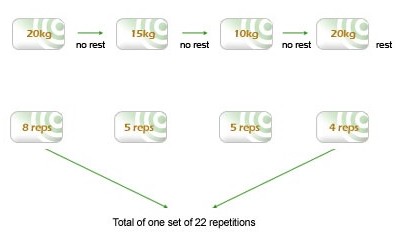There are no shortcuts to building muscle, but by incorporating some smart training strategies into your workout you can maximise your chances of building muscle fast.
One of the best ways of building muscle while at home is to incoporate gradually progressing fitness challenges, like the ones you'll find in our Virtual Events .
Here are some proven training strategies that will safely accelerate your muscle gains in the shortest possible time:
Read on for training advice on:
- How to take your muscle-building training to the next level
- Smart-training techniques for building muscle
- Safety considerations when muscle building
Starting out building muscle mass
Any sensible muscle building program should be carefully structured to permit safe, controlled progression, which in turn will lead to sustainable gains. Throwing yourself headlong into an intensive routine, without due regard for periodisation, will nullify your attempts at maximising your muscle gains. Periodisation brings numerous benefits including:
- Injury prevention
- Physiological adaptation and progression
- Permitting recovery
- Preventing burnout
- Maintaining focus and motivation
Periodisation
Everyone is different and progresses at a different rate dependent upon age, sex, current fitness level and motivation. The following five-phase periodisation structure is appropriate for anyone beginning resistance training with the goal of building muscle mass. More experienced exercisers can jump in at more advanced phases, subject to their current levels of conditioning.
| Phase | Description | Weeks in phase | Sets | Repetitions | Recovery | Notes |
| 1 | Conditioning | 3-6 | 1-3 | 15-20 | 60 seconds | Take longer recoveries between sets if required. |
| 2 | Toning | 3-6 | 2-5 | 12-15 | 60-90 seconds | Weights increase and repetitions decrease. |
| 3 | Toning | 3-6 | 3-8 | 10-15 | 30-90 seconds | Weights and/or sets increase and repetitions decrease. |
| 4 | Hypertrophy (muscle growth) | 3-6 | 4-12 | 8-12 | 30-90 seconds | Working to failure on selected exercises. |
| 5 | Recovery | 3-6 | 2-5 | 10-15 | 30-90 seconds | Reduced intensity to allow body to adapt. |
Smart training techniques
To max your muscles, phase four is the key phase to focus on for your training. Hypertrophy (muscle growth) can be accelerated by using specific smart training techniques, so that you get the most gains from the time you spend in the gym. However, it is important to remember that phases one through to three must be completed before starting phase four because hypertrophy training is extremely intense.
Never sacrifice technique in pursuit of squeezing an extra repetition out. Absolutely perfect technique should be followed at all times. Sacrificing technique will not only result in reduced gains but also potential injury as your body position is compromised to achieve that extra lift. Always allow your body to progress at a steady pace, in a safe and structured way.
Drop sets
This technique recruits a greater range of muscle fibers than a standard lift because you work continuously over a varying weight range.
- Complete one set of a heavy weight (eight to 12 repetitions).
- Without rest, work to failure on a second weight that is approximately 75 per cent of the weight lifted for set one.
- Without rest, work to failure on a third weight that is approximately 75 per cent of the weight lifted for set two.
- Optional - complete one more set (75 per cent of the weight lifted for set three).
For example:

Pre-exhaust
The pre-exhaust technique focuses on fatiguing a muscle and then utilizing it again in a different exercise. Typically it involves using it in isolation and then combined with another muscle. For example: to use the pre-exhaust technique for chest training : Complete three sets of dumbbell bench flyes, with rest periods (chest muscles used in isolation). Complete three sets of dumbbell bench presses, with rest periods (chest muscles used in combination with triceps muscles).
The dumbbell flye exercise fatigues the chest. The dumbbell press utilises the triceps muscles to further exercise the chest to a level that could not be achieved through the dumbbell flye alone because the chest would over fatigue.
Matrix training
This technique is duration focused and utilises several ranges of movement of a muscle to make the set last longer, and hence increase the loading on the muscle. A good example is training the biceps:
- Seven repetitions are completed lifting a dumbbell from full extension to horizontal (effectively a partial repetition).
- Without rest, seven repetitions are completed lifting the dumbbell from horizontal to a full contraction (again a partial repetition).
- Finally, again without rest, seven repetitions are completed for the whole movement, a complete bicep curl from full extension, right up to full contraction at the shoulder.
Forced reps
This technique is extremely intense and should be employed by advanced exercisers only. A training partner or trainer is necessary to assist when you become fatigued.
- A set of repetitions of an exercise is completed to start fatiguing the muscle.
- On the second and later sets, the muscle is exercised to failure but when you cannot lift any more weight; your partner provides a very small amount of assistance to help you complete between one and four more reps.
This technique is very effective because with a partner’s help you are able to complete more repetitions of a heavier weight than you could alone. It is important that your partner provides only just enough help so that you are doing the majority of the work.
Conclusions
To max your muscles, remember the following realbuzz.com rules:
- Periodise your training so that your muscles gradually adapt to increased loading.
- Focus on correct technique at all times for safe progression.
- Use the smart-training techniques for no more than two exercises per training session to avoid severe overload .
These muscle growth techniques are challenging, but proven, and they really work. Incorporate them into a balanced resistance training program and just watch your muscles grow!







